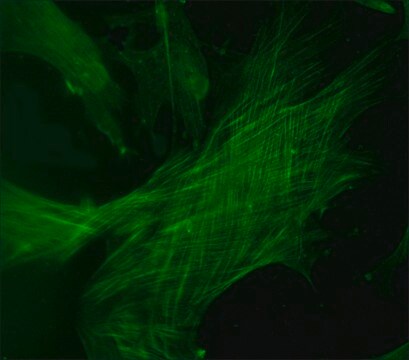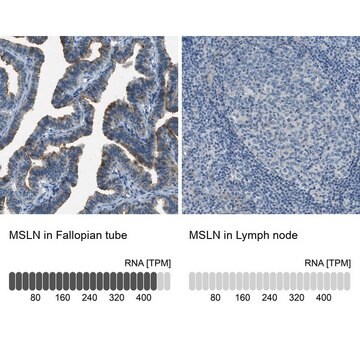MABT1335
Anti-Tropomyosin 3 Antibody, clone 2G10.2
Synonym(e):
Gamma-tropomyosin, Tropomyosin-3, Tropomyosin-5, TPM3, Tm3
About This Item
Empfohlene Produkte
Biologische Quelle
mouse
Antikörperform
purified antibody
Antikörper-Produkttyp
primary antibodies
Klon
2G10.2, monoclonal
Mol-Gew.
~30 kDa (Uncharacterized bands may be observed in some lysates.)
Aufgereinigt durch
using protein G
Speziesreaktivität
human, mouse, rat
Methode(n)
immunofluorescence: suitable
western blot: suitable
Isotyp
IgG2bκ
NCBI-Hinterlegungsnummer
UniProt-Hinterlegungsnummer
Angaben zum Gen
mouse ... TPM3(117557)
Allgemeine Beschreibung
Spezifität
Immunogen
Anwendung
Immunofluorescence Analysis: A representative lot detected Tropomyosin 3 in Immunofluorescence applications (Schevzov, G., et. al. (2011). Bioarchitecture. 1(4):135-164).
Western Blotting Analysis: A representative lot detected Tropomyosin 3 in Western Blotting applications (Schevzov, G., et. al. (2011). Bioarchitecture. 1(4):135-164).
Qualität
Physikalische Form
Lagerung und Haltbarkeit
Sonstige Hinweise
Haftungsausschluss
Sie haben nicht das passende Produkt gefunden?
Probieren Sie unser Produkt-Auswahlhilfe. aus.
Analysenzertifikate (COA)
Suchen Sie nach Analysenzertifikate (COA), indem Sie die Lot-/Chargennummer des Produkts eingeben. Lot- und Chargennummern sind auf dem Produktetikett hinter den Wörtern ‘Lot’ oder ‘Batch’ (Lot oder Charge) zu finden.
Besitzen Sie dieses Produkt bereits?
In der Dokumentenbibliothek finden Sie die Dokumentation zu den Produkten, die Sie kürzlich erworben haben.
Unser Team von Wissenschaftlern verfügt über Erfahrung in allen Forschungsbereichen einschließlich Life Science, Materialwissenschaften, chemischer Synthese, Chromatographie, Analytik und vielen mehr..
Setzen Sie sich mit dem technischen Dienst in Verbindung.








